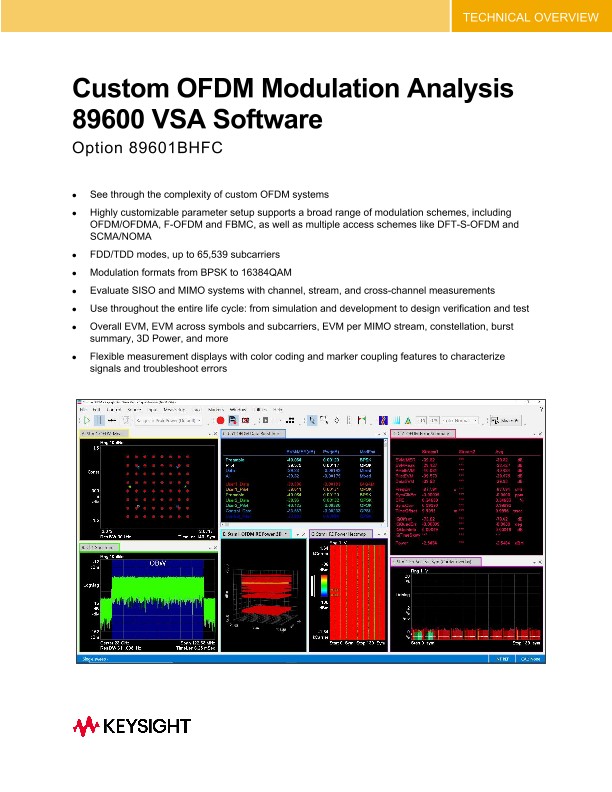
Custom OFDM Modulation Analysis 89600 VSA Software Option 89601BHFC
Technical Overviews
Option 89601BHFC (replacing the 89601B/BN/BK-BHF)
• See through the complexity of custom OFDM systems
• Highly customizable parameter setup handles a wide range of signals
• Flexible measurement displays characterize signals and troubleshoot errors
• Evaluate SISO and MIMO systems with channel, stream, and cross-channel measurements
• Use throughout life-cycle: simulation, development, design verification and test
Custom OFDM Modulation Analysis
Now you can use the Keysight Technologies, Inc. advanced OFDM measurement tools to analyze your custom OFDM formats, including FDD and TDD, MIMO and multi-user systems. Take advantage of Option 89601BHFC’s highly-customizable parameter setup capability, including auto-detection of modulation type and the ability to assign users to subcarriers. Use its analysis capability to perform time- and frequency-selective measurements over some or all carriers or symbols. Make channel, cross-channel, and stream measurements with error analysis on MIMO systems. Custom OFDM is just one of over 75 signal standards and modulation types supported by the 89600 VSA software. The 89600 VSA software is a comprehensive set of tools for demodulation and vector signal analysis. These tools enable you to explore virtually every facet of a signal and optimize your most advanced designs. As you assess the tradeoffs, the 89600 VSA helps you see through the complexity.
Custom OFDM technology overview
Multi-carrier modulation schemes, such as OFDM, represent significant challenges for those seeking to verify PHY-layer characteristics. Most OFDM signals are designed to an open commercial standard, and so are the tools that test them. While traditional spectrum analysis can measure simpler parameters such as frequency, power level, and spectral mask, the more in-depth quality measures such as error vector magnitude, carrier feedthrough, I-Q match, burst parameters, etc. require special capabilities found only with vector signal analysis tools flexible enough to work with custom OFDM systems.
OFDM uses a multicarrier scheme to achieve occupied spectrum efficiencies (data rate per Hz of bandwidth) better than traditional, single-carrier schemes (QPSK, QAM, etc.), and with better immunity to common channel impairments. OFDM is tolerant of multipath; spectral dropouts only affect a limited number of carriers, and the OFDM signal structure lends itself to strong equalization schemes, which can further reduce the effects of multipath. It can be made even more tolerant to multipath with the addition of more channels and MIMO signal processing techniques. Multi-carrier signals such as OFDM offer useful benefits for many digital communications applications, but with a tradeoff in signal and design complexity. OFDM signals are subject to the same sorts of design problems as any vector-modulated signal, but these can be difficult to uncover and troubleshoot without OFDM-specific signal analysis tools.
Easy setup
Easily configure a complete signal description. Define subcarrier parameters per symbol using manual menu selections and text-based configuration files. The 89600 VSA software will read subcarriermodulation formats from a resource modulation file, or will auto-detect the modulation type for blocks of similarly-formatted subcarriers. Use simple and familiar tools like Microsoft Excel or Notepad to create the resource map, preamble IQ files and more.
Analysis and Troubleshooting
Maximum format parameter control
Choose FFT lengths up to 64K and arbitrary guard intervals, plus define an asymmetric number of upper and lower guard sub-carriers. Determine the number of pilots, along with arbitrary positions and modulation formats. In fact, you can choose all data, pilot, and preamble subcarrier/symbol modulation formats separately, using formats as simple as BPSK or as complex as 16384QAM, and assign a user ID to each subcarrier for user-based systems.
Unparalleled measurement flexibility
Troubleshoot signals using a wide range of error analysis tools and measurement displays to characterize your signal. Track down error sources using error tools provided by the 89600 VSA software: EVM by carrier or symbol, summary data with EVM, frequency and IQ errors by input channel, or burst info by signal type. Statistical analysis tools such as CCDF can help you determine component specifications.
Insightful views
Traces are color-coded by modulation format or user ID for easy interpretation. Use as many traces and markers as you need to gain exceptional clarity in viewing your signal.
Perform MIMO analysis using supported multi-channel hardware
Set up the 89600 VSA software to analyze 2x2, 3x3, 4x4, and 8x8 MIMO OFDM systems. Look at input channel data, stream data, and cross-channel data. Important information like common pilot error, MIMO condition number, and an error summary table help you thoroughly analyze these complex systems in a logical and comprehensive manner. For a listing of supported multi-channel platforms, go to www.keysight.com/find/89600_hardware.
Use the same tool to analyze signals throughout development life-cycle
The 89600 VSA software allows you to dynamically input data from either Keysight EEsof ADS or Keysight SystemVue during early development. Option 300 Hardware Connectivity lets you obtain data from hardware using logic analyzers, oscilloscopes, signal analyzers, and modular instruments for multi-domain and cross-domain measurements during prototype development. Finally, use the remote programming capability to develop test programs for design verification and production test. All engineers use the same GUI with consistent setup and measurements, from the beginning to the end of product development.
Capture and re-analyze important signals
The 89600 VSA software includes signal record and playback capabilities. Use it to capture burst and transient signals for analysis. Take advantage of tools like overlap processing for detailed “slow motion” analysis and the spectrogram and cumulative history traces for evaluating the dynamic frequency and amplitude behavior of your signal over time.